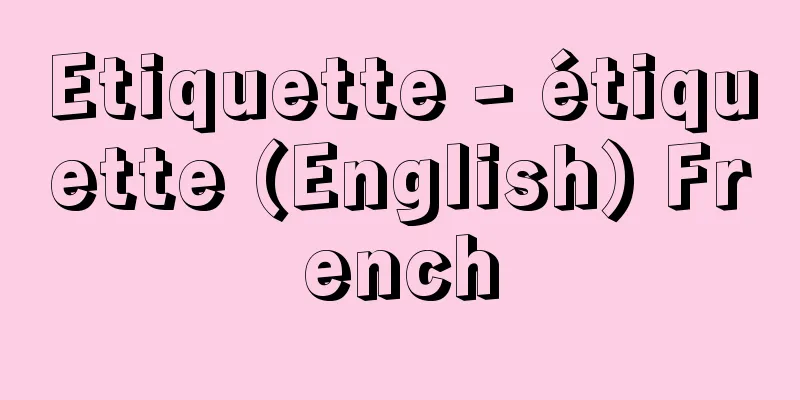Etiquette - étiquette (English) French

|
Refers to etiquette. Its origins lie in the old French word estiquer, meaning to stick on. This originally meant a tag to be stuck on, or a luggage tag, and it is said that it came to refer to etiquette at the Imperial Court due to the need to change the format of letters and other documents depending on the recipient's status or rank. It also refers to a ticket, or a pass that instructed the behavior of those invited to the Imperial Court, and it is said that from this meaning it came to refer to etiquette at the Imperial Court. Eventually it came to be used to mean deciding the seating order of courtiers and ambassadors from various countries, and establishing the accompanying rituals and etiquette. Etiquette first took root in France in the 15th century, with the purpose of showing the status and honor of the courtiers who represented the state to both domestic and international audiences. It eventually spread to the general public, and as the country became more democratic, it became simpler. The customs and etiquette of French bourgeois social circles at the end of the 19th century became the basis of today's etiquette. In modern society, the commonly used term "etiquette" can be described as the mindset and attitude when dealing with everyone other than yourself, including family members. Specifically, etiquette covers not only hierarchical relationships, indoor and outdoor manners, seating order and invitations for ceremonial occasions, and dining etiquette, but also how to make a phone call, drink soup, drink coffee or alcohol, and make a toast. Etiquette itself can also change depending on the environment, or the position you are in. When attending a party for people of higher rank and when attending a gathering for juniors, the dress code, seating order, and greetings are not the same. However, they are essentially the same, and can be summarized as (1) not causing trouble to others, (2) making others like you, and (3) respecting others. In essence, it is a matter of kindness and sensitivity when dealing with others. There is a familiar word called "manners," as exemplified by "table manners." However, the difference between this and etiquette is that while manners refer to general rules such as habits and appearance, etiquette is more demanding, requiring one to have the sensibilities appropriate for a member of society, including more advanced rules, etiquette, and manners. [Asako Ishikawa] Source: Shogakukan Encyclopedia Nipponica About Encyclopedia Nipponica Information | Legend |
|
礼儀作法のこと。古いフランス語estiquer「貼(は)り付ける」に語源をもつ。これは貼り付ける札、つまり荷札という意味があり、ここから、相手の身分や階級などによって手紙などの形式を変えて書くなどの必要性から、宮中における礼法をさすようになったといわれる。また宮廷に招かれた者の行動を指示した通用札(英語ではticket)のことをいい、この意味から宮中における礼法をさすようになったともいう。やがて宮廷人や各国大使の席次を決め、それに伴う儀礼や作法を定める、という意味に用いられた。 エチケットがフランスに定着したのは15世紀ころで、これは国家の代表者たる宮廷人の地位と名誉を内外に示すことを目的としたものであった。それはやがて一般大衆にも浸透していき、その民主化が進むにつれて単純化し、19世紀末のフランス・ブルジョア社交界のしきたりや礼儀作法が、今日のエチケットの基礎となったのである。 現代社会でごく普通にいわれる「エチケット」とは、家族を含めて自分以外のすべての人に接する場合の心構えや態度、ということができよう。具体的には、人間関係の上下や屋内屋外での作法、冠婚葬祭においての席次や招待状、そのときの食事作法などはいうに及ばず、電話のかけ方からスープの飲み方、コーヒーや酒の飲み方、乾杯の仕方にまで、エチケットは存在する。そしてその環境、つまり置かれた立場によって、エチケットそのものが変わる場合もある。目上の人々のパーティーに出席するときと、後輩の会に出席する際では、服装や、席次、挨拶(あいさつ)の仕方も同一ではない。ただし、本質的には変わるものではなく、基本的には、(1)他人に迷惑をかけない、(2)他人に好感を与える、(3)他人を尊敬する、ということに集約されよう。要は、他人と接するときにもつ優しさと感性の問題であろう。 テーブルマナーtable mannerなどに代表されるマナーという耳慣れたことばがあるが、エチケットとの相違点は、マナーが習慣や身だしなみなど一般的なルールをさすのに対し、エチケットは、さらに高度な規則や礼儀、作法など、社会人としてふさわしい感性をもつべきとする、要求度の高いものであると認識する必要があろう。 [石川朝子] 出典 小学館 日本大百科全書(ニッポニカ)日本大百科全書(ニッポニカ)について 情報 | 凡例 |
Recommend
Hay
…the inhabitants of the region of Armenia where I...
Valerian root - Kissokon
〘Noun〙 A brown, aromatic, bitter-tasting herb made...
organdy finishing
…Also, concentrated sulfuric acid or cold caustic...
Needlework - Hariko
A girl employed by a tailor to sew. Ohariko. ※Thre...
Ivanovsky, DA - Iwanofuski
…Tobacco mosaic disease has long been known as a ...
Quickie - Quickie
However, unlike regular feature films, "B&qu...
Mount Kinpu
A mountain on the border between Nagano and Yamana...
Dendroaspis jamesoni (English spelling) Dendroaspis jamesoni
… [Takahiro Matsui]. … *Some of the terminology t...
Prince Kuni
One of the titles of the former Imperial family. I...
A view of investigation based on questioning -
...There is some debate about how current law str...
Glass crafts
As a material for crafts, glass has unique and ex...
Star of Bethlehem
...The appearance of a star, as an expression of ...
Mount Kasaboshi
...Elevation 2295m. To the northeast, a series of...
Croomia japonica (English spelling) Croomia japonica
…[Tetsuichi Yahara]. … *Some of the terminology t...
Glacial acetic acid
… [nature] It is a colorless liquid with a strong...





![Monbetsu [town] - Monbetsu](/upload/images/67cd08d7d6472.webp)



